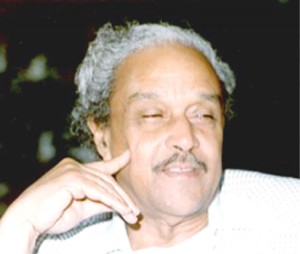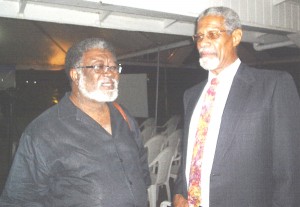Hailed as a “quiet revolutionary” in the “quiet revolution” of West Indian Literature, Guyanese writer, Theodore Wilson Harris was the subject of a special gathering as the 28th Conference of West Indian Literature opened at the Georgetown Club on Sunday.

Even though the eminent New-Amsterdam born writer was not present on the lawns of the Club, his presence loomed large as several distinguished academics and writers spoke of his contributions to Caribbean literature. Describ-ing him as “astonishingly prolific” and “profoundly humane”, Alim Hosein, member of the Coordinating Committee for the conference, declared that Harris is one of the pioneers of form in Caribbean literature.
Professor Mark McWatt of the University of the West Indies, speaking on ‘The Guyana Landscape and the Language of the Imagination in the fiction of Wilson Harris’, drew the audience into the work of the writer and the role Guyana’s landscape played in his work. He quoted Harris, who said in an interview that “the landscape is a living text, it’s alive”.

According to McWatt, while the literature of Guyana shares common features with the English-speaking Caribbean, it has been noted that there is some “strangeness” in Guyanese writing. The professor said that fingers have been pointed at Guyana’s landscape as a reason for this. “Perhaps the most disturbing feature of much of Guyana’s landscape to the minds that confront it, is its size and scale, which seem beyond human needs and design,” he said. “Part of the quietly revolutionary art of Wilson Harris’ writings is his ability to read in the landscape and to reproduce in his fiction, the human emotions of fear and dread.”
Professor McWatt noted that Harris has said that much of literature that deals with landscape is a one-sided discourse and posited that this is not the case in the eminent writer’s work.
Meantime, Director of the University of Guyana’s Berbice Campus, Daizal Samad said that the West Indies is a minute place but it has produced a surprising number of literary giants. He asserted that Harris’s first published novel, Palace of the Peacock was an evolutionary moment in literary development in English. He said that the writer’s work contributed to ways that language can be used in fabulously creative and re-creative ways declaring that Harris “paints in words. He designs characters that are linked in spirit and bones to each other.”
Professor Samad asserted that for him, Harris’s “greatest significance may well be his mythopoeic vision he has of the living West Indian customs”.
Dean of the School of Education and Humanities at the University of Guyana, Al Creighton speaking on ‘The Quiet Revolutions in West Indian Literature and Criticism’ traced the evolution of Caribbean writing over the years noting that “the quiet revolution that took place in the area of language is phenomenal”. He said that there were revolutionary changes from imitating the language of the master to the mastering of the language by succeeding generations of West Indian writers.
Another quiet revolution, he said, was the gradual inclusion of comparative literature into the “mainstream of what we do in West Indian Literature”.
An important and relevant factor, without which the revolution would not be completed and which is as important as the literature itself, Creighton declared, is the “final quiet revolution” which is the criticism of West Indian literature. He noted that this revolution took place when the criticism began to recognize and define the various new developments.
One of Guyana’s best known writers, Harris was born in New Amsterdam in British Guiana and attended Queen’s College after which he studied land surveying and begun to work as a government surveyor in 1942, rising to senior surveyor in 1955. In this period Harris became intimately acquainted with the Guyanese interior and with the Amerindian presence, his profile on the Peepal Tree Press website said. Between 1945 to1961, Harris was a regular contributor of stories, poems and essays to Kyk-over-Al and was part of a group of Guyanese intellectuals that included Martin Carter, Sidney Singh, Ivan Van Sertima and Milton Williams. His first publication was a chapbook of poems, Fetish, (1951) under the pseudonym Kona Waruk, followed by the more substantial Eternity to Season (1954) which announced Harris’s commitment to a cross-cultural vision in the arts, linking the Homeric to the Guyanese. Harris’s first published novel was Palace of the Peacock (1969), followed by a further 23 novels with The Ghost of Memory (2006) as the most recent. He lives in the United Kingdom.
The 28th Conference on West Indian Literature is being held under the theme ‘The Quiet Revolutions in West Indian Literature and Criticism’ and it is being hosted by the School of Education and Humanities of the University of Guyana. UG’s Vice-Chancellor Professor Lawrence Carrington officially declared the conference open on Sunday.
The conference will also include a centenary celebration of the life and work of the pioneering work of Guyanese writer, Edgar Mittelholzer, which will be held this evening. The conference ends tomorrow. The last time it was held in Guyana was in 2000.



